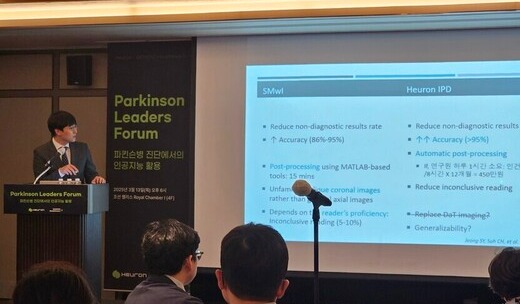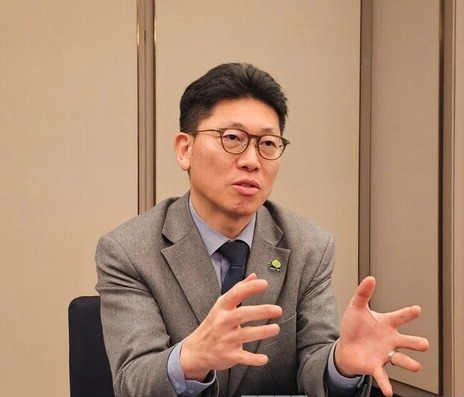Radiology experts recently discussed the role of MRI-based artificial intelligence (AI) solutions in differentiating neurodegenerative diseases and the potential for cost-effective and accessible alternatives to conventional dopamine transporter PET scans in diagnosing Parkinson's disease.
Heuron, a medical AI company specializing in neurological diseases, hosted the “Parkinson Leaders Forum - Artificial Intelligence in Parkinson's Disease Diagnosis” in collaboration with Siemens Healthineers at Josun Palace in Seoul last Thursday. The forum, chaired by Heuron CEO Shin Dong-hoon, a neurologist, and CMO Aleum Lee, a professor of radiology at Soonchunhyang University Bucheon Hospital, was attended by domestic and international radiology experts. The discussions focused on the importance of early diagnosis of Parkinson's disease and how to efficiently leverage AI technology.

One of the speakers, Suh Jong-hyun, a professor of radiology at Asan Medical Center, shared his experience with the clinical use of Heuron's AI solution. “Compared to the existing imaging technique, SWI (Susceptibility-Weighted Imaging), it effectively reduces the effect of movement during imaging and provides significantly higher diagnostic performance,” Suh said, referring to the SMWI (Synthetic MR Weighted Imaging) technique used by Heuron IPD, an AI solution for MRI-based Parkinson's disease diagnosis.
The biggest advantage of Heuron's AI solution is its automated processing, which is expected to reduce workload and labor costs. “If a researcher handles the same task manually, it takes 15 minutes per case, which translates to a labor cost of 4.5 million won per year,” he said.
Suh also shared his experience with the differences between equipment manufacturers. “When we first introduced the Heuron IPD product in early 2022, the accuracy was lower than expected, which was likely because the training data was mainly obtained from Siemens Healthineers MRIs, while we were using Philips equipment,” he explained. Afterward, his team collaborated with Heuron to develop an algorithm optimized for Philips equipment and found that the improved system achieved an impressive 0.967 AUC.
“We believe that nigrosome region analysis with MRI will play a complementary role to dopamine transporter imaging (DaT imaging) rather than replace it,” said Suh, suggesting that its most effective use would be in differentiating essential tremor (ET) from Parkinson's disease, thus reducing the need for unnecessary dopamine transporter PET scans.
SMWI can be useful for differential diagnosis because, when accurately imaged, nearly 100 percent loss of nigral hyperintensity is observed in idiopathic Parkinson's disease (IPD), Parkinson's type multisystem atrophy (MSA-P), and progressive supranuclear palsy (PSP), according to Suh. It is expected to play an important role in reducing unnecessary PET examinations by helping to rule out essential tremor (ET) or drug-induced parkinsonism (DIP), he added.
Dr. Elon Wallert from the Amsterdam University Medical Center in the Netherlands, who joined the event remotely, also highlighted the differential diagnostic potential of Heuron's AI solution. Dr. Wallert and his team evaluated the performance of Heuron's AI solution in 180 patients who underwent single-photon emission computed tomography (SPECT) scans of dopamine transporters for clinically indeterminate diagnoses.
“This is the first study to evaluate the diagnostic accuracy of SMWI sequences in a real-world patient population in a clinical setting, and we found that the software was 86.4 percent accurate in differentiating neurodegenerative parkinsonism from non-neurodegenerative parkinsonism, improving to 94.3 percent under certain conditions,” said Dr. Wallert.
Notably, diagnostic accuracy improved when the software assisted the radiologist's reading, and inter-rater agreement increased from “substantial” to “almost perfect.” “This shows that AI is complementary to, not a replacement for, radiologists in the clinical setting,” Dr. Wallert added.

At the event, in a separate interview, Heuron CEO Shin Dong-hoon discussed the latest trends in Parkinson's disease diagnosis and the role of MRI-based AI solutions, emphasizing that they offer a cost-effective and accessible alternative to traditional dopamine transporter imaging.
“The diagnosis of Parkinson's disease has traditionally been made through neurological examinations and dopamine transporter imaging, but these are limited by radiation exposure, high cost, and inaccessibility,” said Shin. “By utilizing MRI-based AI solutions, dopamine neuron damage can be assessed without radiation exposure, and the diagnostic performance is on par with dopamine transporter imaging, with a sensitivity of 94 percent and specificity of 92 percent.”
In particular, screening patients with normal structures using MRI first can reduce the number of unnecessary PET scans, which is a significant alternative in terms of patient burden and health insurance cost savings, he noted.
When asked about the adoption status of Heuron's solution, Shin said, “We are currently conducting research and clinical applications at major hospitals in Korea, including Asan Medical Center, Severance Hospital, Korea University Ansan Hospital, Sanggye Paik Hospital, Soonchunhyang University Bucheon Hospital, Hallym University Dongtan Sacred Heart Hospital, and Pusan National University Yangsan Hospital.”
Heuron is also collaborating with the Amsterdam Hospital in the Netherlands and Singapore General Hospital.
In Korea, Heuron’s solution is being used in some health screening centers on a non-reimbursement basis but it needs to be covered by medical insurance, Shin noted.
“We plan to expand research collaborations so that more physicians can experience and evaluate it firsthand.”
According to Shin, Heuron’s Parkinson's diagnostic aid has been licensed in Singapore.
The company is prioritizing expansion in Asian markets such as Taiwan and Thailand, and later expand into Japan, Vietnam, and Indonesia.
To enter the U.S. market, it is essential to establish a local corporation and build a hospital network, as well as winning FDA approval, which requires a minimum of five to seven years of preparation, Shin said.
“In the long term, we will achieve the No. 1 position in Asia and then move forward in stages to enter the U.S. market.”
Shin, a former professor of neurology at Gachon University Gil Medical Center, said, “The goal is for the AI-based MRI analysis solution to become a standard process for diagnosing Parkinson's disease and provide practical help to patients not only domestically but also globally.”
Related articles
- Heuron partners with Japan’s Doctor Net to expand AI stroke solution overseas
- Heuron's AI diagnostic solution for Parkinson's disease published in AJNR
- Heuron’s diagnosis-assisting AI solution for Parkinson's shows over 90% accuracy
- Heuron gets certification of its AI solution to diagnose Parkinson's disease
- Heuron signs agency contract with Thai medical AI software distributor
- Heuron appoints Singaporean Parkinson's expert as clinical advisor to boost AI solutions

